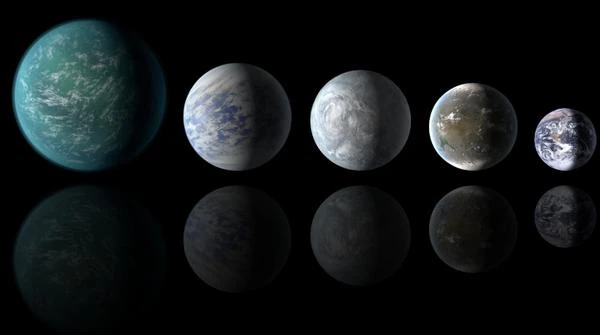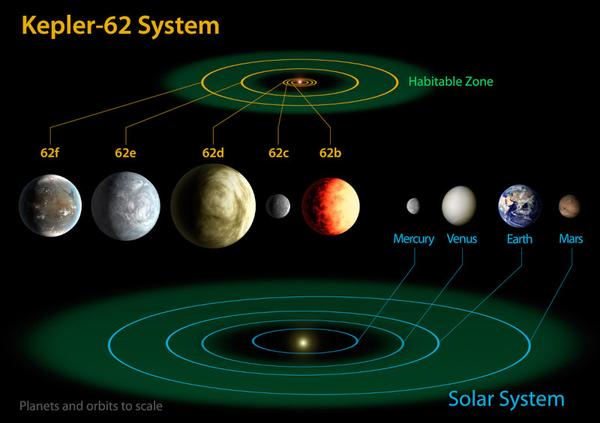
In December 2011, NASA confirmed the discovery of the first planet located in the Habitable Zone of its star. It was the exoplanet Kepler-22b.
In April 2013, two new planetary systems were discovered, Kepler-62 and Kepler-69. The Kepler-62 system has five planets: 62b, 62c, 62d, 62e, and 62f. The Kepler-69 system has two planets, 69b and 69c, including three super-Earths (Kepler-62e, 62f, and 69c) that are in the "habitable zone," meaning they could contain liquid water.
Kepler-62 is a star smaller and cooler than the Sun. The exoplanet Kepler-62f, with a rocky composition, is only 40% larger than Earth and is located in the habitable zone of its star, orbiting in 267 days.
Kepler-62e is 60% larger than Earth and is also located in the habitable zone of its star. However, it orbits on the inner edge of the habitable zone in 122 days.
The third planet, Kepler-69c, whose composition is unknown, is 70% larger than Earth and its 242-day orbit (like Venus) is in the habitable zone of the star Kepler-69, which is similar to our Sun.
Since scientists have been able to detect exoplanets, they have been searching for worlds similar to our Earth because the ultimate goal is, of course, to find conditions favorable for the emergence of life in the universe, to answer the age-old question that has always troubled humanity, "Are we alone in the universe?"
Each discovery brings us one step closer to this goal; it is now only a matter of time before we know if our galaxy is teeming with Earth-like planets or if we are a rarity.
Kepler, the more than one-ton space telescope, set off towards the Milky Way on March 6, 2009, in search of extrasolar planets or exoplanets. The planets that the Kepler telescope will search for are small exo-Earths (2 to 20 times the size of Earth), which the Corot space telescope, in orbit since 2003, cannot detect.
The Kepler space telescope simultaneously and continuously observes the brightness of more than 150,000 stars.

The two habitable zone planets, Kepler-62e and 62f, have three companions on closer orbits to their star. Two are larger than Earth, and one is the size of Mars; these are Kepler-62b, Kepler-62c, and Kepler-62d. They orbit their star in 5, 12, and 18 days, respectively, making them very hot and inhospitable for life as we know it on Earth.
The five planets of the system orbit the star Kepler-62, which is barely two-thirds the size of our Sun with only one-fifth its luminosity. The star Kepler-62, located 1,200 light-years from Earth in the constellation Lyra, is seven billion years old (2 billion years older than the Sun).
The Kepler-69 system belongs to the same class of stars as our Sun (Type-G) and consists of a star that is 93% the size of the Sun and 80% as luminous. It is located approximately 2,700 light-years from the Sun in the constellation Cygnus.
Kepler-69c is 70% larger than Earth and orbits in 242 days (like Venus) in the habitable zone of the star Kepler-69. Its companion (Kepler-69b) is more than twice the size of Earth and orbits its star in 13 days.
When a "life candidate" planet transits or passes in front of the star relative to the space telescope, a percentage of the star's light is blocked. The decrease in the star's brightness reveals the size of the planet transiting its star. Using this transit method, Kepler has detected 2,740 candidates.
Various analysis techniques and ground-based telescopes have confirmed 122 exoplanets. At the beginning of the mission, the Kepler telescope only found giant gaseous planets (hot Jupiters) on very close orbits to their stars, which were easier to detect due to their size and very short orbital periods.
To detect a planet like Earth, it takes three years because it must complete the three transits necessary to be accepted as a planet candidate.
N.B.:
A transit occurs each time the planet passes between its star and the observer. At that moment, the planet blocks a bit of the star's light, producing a detectable periodic dimming. Kepler needs at least three transits to verify a signal as that of a planet.